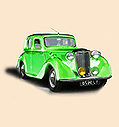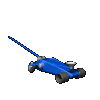|
End of Menu Items |
Technical Data for the MG Y Series'YA' or 'YB'? That is the Question |
It is not hard to pick up a copy of a motoring article on the 'New' M.G. One and a Quarter Litre Saloon. The press have always printed full road tests and technically detailed articles on new models. So if you want to find out about your 'YA', today you can buy booklets from Brooklands Books entitled "MG 'Y' Types & Magnette ZA/ZB", (see Book Review). YAs, YTs and ZAs abound in its 92 pages of old article reprints, but very little on the YB or even ZB. By the time MG came to update these cars, the news was not so important, especially if very little external differences could be seen on the 'updated', or 'face-lifted' model. For we enthusiasts, this leads to many people not even knowing there was an updated 'Y' series, the 'YB', and even fewer who know how to tell them apart from the 'YA'. Worse is the fact M.G. themselves did not 'add' the relevant update till quite a few 'YB's had been built. The press would rather show a face-lift as news, bits you cannot see being updated are not as interesting, or newsworthy.
Strange as it may seem, the YA carried over some rather ancient engineering from pre-war Morris models. Though the 'YA' (I call it the YA, though it was only the 'Y' until the inception of the 'YB' had rack and pinion steering with independent front suspension, (IFS) it still had single-leading-shoe (SLS) front brakes. The IFS and steering put the car miles ahead of contemporary efforts by others, such as Austin and Ford, but the YA brakes were not known for their efficiency. It was only when the TD was developed on the Y's excellent thin-walled 14swg boxed-in chassis, that all-new Lockheed twin-leading-shoe, (TLS) front brakes arrived. According to MG literature, these TLS brakes were fitted from YB number 286, so from the first car at 251, YA parts were still used! Rear brakes remained with a 'single-leading' shoe, and one 'trailing' shoe, or the car would have become virtually brake-less in reverse. For the uninitiated, 'leading-shoes' are those that come on and are actually 'dragged' on more in a 'self-servo' action by the rotation of the brake drum, giving far better braking if travelling forwards. A leading shoe has its leading edge touch the drum first. A 'trailing-shoe' is one that the rotation of the brake drum tries to 'push-away' the shoe, hindering the brake's action, (but in reverse this 'trailing-shoe' becomes a 'leading shoe'). Lo and behold, BMC re-introduced the SLS front brakes on the 1959 Mini, to keep costs low. Those who drove these early Mini's will remember those brakes. BMC were soon forced to fit TLS brakes, then discs, then servo-discs.
So the YB gained the later 'Nuffield' twin leading shoe front brakes from the TD, though such a system requires two front brake cylinders to each side, as each shoe is individually operated. It has been known for amateur restorers to fit the brake back-plates onto the wrong side of the car, continuing to assemble the brakes in such a fashion they have ended up with a full set of 'trailing' shoes. As the car will have awful forward brakes, the MoT examiner soon picks this error up. Not only did the 'YB' braking system gain modern drum brake technology, the system itself was different from that fitted to the previous YB. The YB drums were also once piece- wheel bearing hubs, the drums could not be removed separately as on the 'YA'.
Well into YB production at car number 286 again, the rear axle was changed from the 'Morris banjo' spiral-bevel type to the 'Nuffield' split variety, with hypoid-gears. This was much stronger, quieter, and longer lived than the pre-war Morris unit fitted to the 'YA'. The 'YB' axle gained the one-piece five-stud brake drums as well, fitting onto a locating taper, and splined drive shaft end with a very large nut. Hiding all this brake technology were 5.50 by 15 inch wheels, one inch smaller than those on the YA of 5.00 by 16 inch. To improve the looks of the model, YB rear wings were given a deeper skirt than the YA, this being the most obvious visual difference between the two versions. Deeper rear wings must have been a current styling fad, as the 803cc Morris Minor S2 also lost its slimmer rear wings to deeper versions on the 948cc Minor 1000 shortly after. Chromed steel hubcaps on the YB were smaller, and had an unpainted 'M.G.' motif, cast in Mazak, in the centre. These hubcaps are identical to those on the TD, TF, ZA, ZB, ZBV, and Farina Magnettes, though after 1960 they are stainless steel pressings. Well hidden from view was a more modern brake master-cylinder mounted aft of the pedal-box. Not only the type of rear axle, but also rear axle ratios differed between the YA and YB, but only because of the wheel sizes; the YA was 5.143:1 and the YB was 5.125:1, (the same ratio used in the Wolseley 4/44 and Morris MO series. These cars only had standard BMC four stud wheel fixings though).
The spare wheel cover was enlarged on the YB to take the larger section 5.50 tyre, but this is hard to see with the eye. Other supposed updates of the electrical system were fed in piecemeal, current books say the YB had a later Lucas RB106 control box with separate fuse box, though early YB owners such as myself will tell you these were not fitted for quite some months into production, at car number 326 to be exact. A bit like saying the 'YB' has the SC2 version of the XPAG engine, when in fact a number of the last 'YA's had this engine with the integral oil filter cast onto the side of the oil pump.
I recently read that the YA did not handle as well as was expected. It roll-over-steered a little to readily, and considering it had a rear panhard rod to control rear axle side-movement this surprised me. Anyway, M.G. decided the panhard rod was expensive and not required so deleted it from the 'YB'. At the same time M.G. modified the IFS geometry by lowering the bottom wishbone fulcrum point on the chassis cross member. You can see the "welded on" bracket the lower arms now bolted to, between the arms and the cross member. This lowered the roll centre, and to ensure the car sat better on corners, a front anti-roll bar was fitted. As the MGA and MGB use a virtually identical IFS system, it is again interesting to see how these sports cars anti-roll bars link to the suspension, when compared to the YB's arrangement. On the YB the link bolts to the upper flat face of the spring seat. These crack after many years use around the bolt heads. On the other cars, the link bolts to holes drilled in the front wishbone arm; a much stronger position. Nice to know that MGA lower arms and seat pans fit a 'Y' type, (as do MGB items, especially the longer life MGB V8 inner bushes). The sports car king pins are very different though look similar externally.
Dampers were improved at the rear on the YB, though their basic 'lever-arm' design was similar. The YB has heavy-duty rear dampers. Road tests spoke of the better twin-tone horns of the YB, but these were not fitted to production models until car number 460. Headlamp shells were smaller on the YB to take the standard seven-inch Lucas pre-focus lamp unit, but again this was not easily seen by the eye.
So really it is hard to decide exactly where the YB began. What with late YAs getting the later engine, and other parts taking ages to arrive, or was it just a case of using up current production items, and feeding in the new parts when old items ran out? M.G. must have taken the decision at a point in production to say, "YBs start here".
It is a little worrying when you realise that the last YA was number Y 7285, and the first YB was YB 0251 leaving Abingdon on 21 November 1951, when the only real difference between the two was the wheel size, anti-roll bar, lower bottom wishbone, and rear wing valance depth. The YA already had the SC2 XPAG engine, and the other 'updated' items would arrive some months later. Improved TLS brakes and better rear axle on car YB 0286, control box on car YB 0326, and finally twin tone horns on car YB 0460.
What would Trading Standards make of that today? The adverts had promised all the updates. Perhaps that is why the motoring press was reluctant in those days to feature 'updated cars'. They knew only too well the problems of supply and demand. If you need an in-depth look at what I have touched on light heartedly, you need David Lawrence's book "Let There Be 'Y's" (ISBN 0-620-21832-0), and John Lawson's, "M.G. Y Type Saloons and Tourers." (ISBN 0-947981-31-4).
A Printer-friendly version of this page can be downloaded here.


